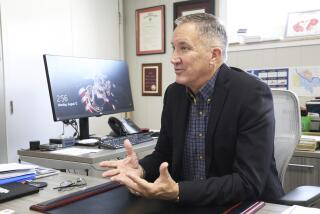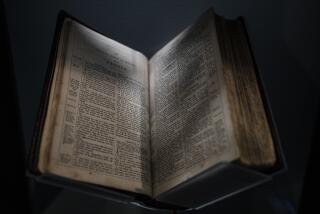Public schools struggle with lessons about Islam amid renewed fears of terrorism
The assignment on world religions that was handed out to students at Riverheads High School in rural Virginia seemed pretty simple, on its face.
A teacher’s printout explained why calligraphy was religiously significant to Muslims. The assignment asked students to re-create the complex strokes for the Shahada, the Islamic statement of faith, “to give you an idea of the artistic complexity of the calligraphy.”
The Shahada was not translated, but in Arabic, it states, “There is no god but God, and Mohammed is his messenger.”
It was religious indoctrination, parents charged. The angry calls and messages that flooded the district grew so intense last week that Augusta County school officials shut down the district Friday, keeping 10,500 students home “out of an abundance of caution.”
The incident was just the latest in a series of disputes involving Islam and the classroom, which come as the nation experiences a rise in anti-Muslim attacks and vandalism and renewed fears of terrorism after the bloodshed in Paris and San Bernardino.
Another community uproar in Georgia this fall led state officials to yank a sample classroom guide that said Islam, Christianity and Judaism share the “same God,” which many theologians argue is basically accurate, albeit philosophically complicated.
In October, a lawmaker in Tennessee introduced a bill that would forbid lessons about Islam until children reach high school, saying she feared the “indoctrination” of young students.
“It seems like it’s been happening more frequently as Islamophobia rises,” said journalist and author Linda K. Wertheimer, who explores religious controversies in public schools in her new book, “Faith Ed., Teaching About Religion in an Age of Intolerance.”
When teaching about Islam causes a stir, Wertheimer said, “the common thread was a fear of Islam.”
In America, the constitutional line that separates church and state has often been closely policed in the public school system, where battles over schoolhouse prayer and creationism have ended up in courtrooms and legislatures.
Experts say what’s often not understood by parents today is that it’s legal to teach about religion in public schools, a key exception carved out by the Supreme Court back when the battle was over Protestant Christianity’s common appearance in the classroom.
In 1963, the Supreme Court ruled that it was unconstitutional for a Pennsylvania school to read 10 Bible verses to students each morning, without comment or context, and to make the students recite the Lord’s Prayer. (The case was brought by a family of Unitarians.)
But in Justice Tom C. Clark’s opinion, he wrote that “one’s education is not complete without a study of comparative religion or the history of religion and its relationship to the advancement of civilization.” The key, he said, was presenting religion “objectively as part of a secular program of education.”
The Supreme Court’s firm decision to keep prayer out of public schools sparked some backlash, but it also led to a push for teachers to be better trained to teach about world religions, said Diane L. Moore, director of the Religious Literacy Project at the Harvard Divinity School.
Many states eventually adopted guidelines whose curricula included teaching about Islam and other faiths, but Moore said teachers today “are really in an untenable position” because “very few of them have been exposed to the study of religion in their training.”
In 2010, the American Academy of Religion, seeking uniform guidelines for K-12 teachers, suggested “encouraging student awareness of religions, but not acceptance of a particular religion.”
The academy’s report said common student questions included whether Islam is a violent religion. The report suggested that teachers respond that “Islam (like Christianity, Buddhism, Paganism, etc.) is neither violent nor nonviolent. In the hands of believers, all religious expressions are capable of being interpreted in ways that can inspire the full range of human agency from the heinous to the heroic.”
The conservative-leaning Campus Watch, a watchdog of Middle East studies and Islam in North American education, has criticized educators for “whitewashing” Islam’s history.
See more of our top stories on Facebook >>
“Not infrequently, lessons about Islam tend toward apologetics,” said Winfield Myers, director of Campus Watch. “What we find in schools … is a portrayal of Islam in a very positive light and a portrayal of Christianity and Judaism in a very negative light.” Myers said he wants a “balanced view that recognizes the good and bad” of Islam and Western civilization.
As for the controversial lesson in Virginia, Myers said, “We have utterly no objection to practicing Arabic calligraphy.” But he added, “If you were learning Greek, it would be unlikely a public school teacher would have you learn in Greek by writing ‘Jesus Christ is our lord and savior.’”
But Peter Hart, spokesman for the nonprofit National Coalition Against Censorship, said teachers “are in the best position to make decisions” about how to handle curricula, calling “the hysteria over Islamic indoctrination … a new feature probably this school year.”
Hart acknowledged that some assignments may not be “particularly careful or wise. … There can be some legitimate complaints about whether practicing calligraphy is the best way to [learn about] Islam.”
However, Hart added, “what people seem to want is a public school system that affirms their own viewpoint or affirms their own ideology, and that’s not what the public schools are supposed to do.”
Twitter: @MattDPearce
ALSO
Pentagon weighs cybercampaign against Islamic State
Pastor delivers fiery eulogy at memorial service for San Bernardino shooting victim
Female attackers are still few among Islamic extremist groups
More to Read
Sign up for Essential California
The most important California stories and recommendations in your inbox every morning.
You may occasionally receive promotional content from the Los Angeles Times.











